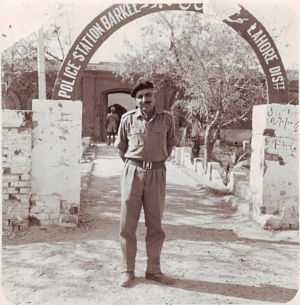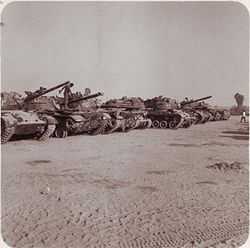Lahore Front
| Battle of Lahore | |||||||
|---|---|---|---|---|---|---|---|
| Part of Indo-Pakistani War of 1965 | |||||||
 Lt. Col. Hari Singh of the India's 18th Cavalry posing outside a captured Pakistani police station (Barkee) in Lahore District. | |||||||
| |||||||
| Belligerents | |||||||
|
India |
Pakistan | ||||||
| Commanders and leaders | |||||||
|
|
| ||||||
| Strength | |||||||
|
100,000 1 Armored division |
50,000 2 Armored division | ||||||
| Casualties and losses | |||||||
| Unknown | Unknown | ||||||
| ||||||
The Battle of Lahore (Urdu: لاہور کی لڑائی, Hindi: लाहौर की लड़ाई Lāhaur kī laḍ.āī) or the Lahore Front were a series of battles in the Indo-Pakistani War of 1965 fought in around Lahore. The battle ended with an Indian tactical victory. However Indian forces halted their assault on Lahore once they had reached captured the village of Burki.[8] The rationale for this was that a ceasefire was to be signed soon, and had India captured Lahore it would likely have been returned in ceasefire negotiations.[9][10][11]
Prelude
After losing hope of a plebiscite in Kashmir, the Pakistani Army invaded the Indian part of Kashmir through a covert operation dubbed Operation Gibraltar.[12] After the Indians spotted the infiltrators, the Indian Army eliminated the saboteurs and inflicted casualties on Pakistani posts across the Cease Fire Line.[12] Pakistan retaliated by launching Operation Grand Slam on 17 August 1965 in an effort to relieve infiltrators who had been surrounded after the failure of Operation Gibraltar on 15 August and to attempt to cut off the Indian supply lines.[12] To relieve forces almost cut off in their part of Kashmir, India then counterattacked by crossing the international border further south with the intention of diverting Pakistani units that were participating in Operation Grand Slam.[12] India's goal was to take distract Pakistani Army's attention and resources away from Operation Grand Slam where unprepared Indian troops were at severe disadvantage against the Pakistani offensive.[12]
The battle
On the night of 5–6 September 1965, Indian XI Corps began its operations by advancing towards Lahore along three axes – Amritsar-Lahore, Khalra-Burki- Lahore and Khem Karan-Kasur roads, overwhelming the small Pakistani force.[13] Pakistan's 10 and 11 Divisions, which were deployed in the sector, began a series of rather confused delaying actions, and by the end of the first day the Indian infantry, backed by heavy armoured troops, were within striking distance of Lahore city. Some advance Indian units managed to capture Ichhogil canal on 6 September but soon withdrew, since support and reinforcements were not expected to reach any time soon.[5]
Pakistani soon launched a three pronged counterattack to counter Indian assault on 8 September[14] backed by its newly created 1 and 6 Armoured division to break through the front line formed by Indian 4 Grenadiers, 9 Jammu and Kashmir rifles, 1 & 9 Gurkha rifles and Rajput Rifles.[15]

On 8th, Pakistan began counterattack south of Lahore from Kasur towards Khem Karan, an Indian town 5 km from International Border. This was followed by another major armoured on 9 ans 10 September to recapture lost ground despite heavy toll on Pakistani armour.[15] The Pakistani counterattack led to the capture of the village Khem Karan.[17] However a massive Indian counterattack repulsed the Pakistani forces from this sector of Indian territory. Continued heavy attrition specially on Pakistani armour however meant Pakistan could not continue the counterattack from 10 onwards.[15]
Along the Amritsar-Lahore and Khalra-Burki-Lahore axis in middle Indian infantry won decisive battle at Burki.[14] Pakistani counterattack which started on 8th Pakistani artillery pounding Indian advance on 8,9 and 10 September.[3] Indian units continued their advance, and by 22 September, had reached the Ichhogil canal protecting the city of Lahore.[1] Pakistani counterattacks were effectively tackled at Burki with little armour support on 10th punishing Pakistani armour.[14] Indian advance then moved on to capture Dograi, a town in the immediate vicinity of Lahore.[5] After reaching the outskirts of Lahore Indian Army ensured that Lahore came under constant Indian tank fire to prepare for the main assault on Lahore city before ceasefire was announced.[7]
In the north India won another decisive battle at Phillora supported by its 1 Armoured Division on 11th destroying the Pakistani counterattack.[5] Indians continued to advance towards Chawinda in the north from Phillora and reached Chawinda by 17 September.[18] However, they were halted at Chawinda till ceasefire on 22 September. This was a result of the exceptional defences backed by artillery were created by Pakistani Brigadier A.A.K. Niazi who had started preparing the defences soon after fall of Phillora. Indian attack in the north only lost momentum at the Battle of Chawinda, after more than 500 km2 of Pakistani territory had been captured.[6] The Pakistanis being helped by the fact that the network of canals and streams in the sector made for natural defensive barriers. In addition, the prepared defence, comprising minefields, dugouts and more elaborate pillboxes, proved problematic for the Indians.[1]
Aftermath
Even after the capture of Dograi on 20–21 September no attempt was made to capture Lahore and the main assault on Lahore was not launched because a ceasefire was to be signed in the following couple of days and it was known that the city would have been given back to even if it was captured.[19] By choosing to attack Lahore, the Indians had managed to relieve pressure from Chumb and Akhnoor in Kashmir, forcing the Pakistan Army to defend further south.[1]
Former Pakistani president Pervez Musharraf asserted that "Pakistan certainly achieved a tactical victory in the sense that we conquered more territory, inflicted more casualties, took more prisoners, and almost blew the Indian Air Force out of the air."[6]
At the end of hostilities on 23 September India retained Between 140 square miles(War Despatches by Lt. Gen.Harbaksh Singh)and 360 square kilometres(official Indian History of 1965 war) of Pakistani territory in the lahore front including major villages of Bedian,Barki,Padri,Dograi,Bhasin and Ichhogil uttar along the eastern bank of the Ichhogil canal.Pakistan only gained small tract of land in Khem Karan of 52 square kilometres.[20][21]
Awards
The Fighting Fifth Battalion of Indian Army which played an important part in capturing Burki was later was conferred with “Battle Honour of Burki” and “Theatre of Honour, Punjab”.[22]
The Pakistani commander, Major Raja Aziz Bhatti, was later awarded the Nishan-e-Haider, the highest military decoration given by Pakistan for the battle at Burki, posthumously. Each year he is honoured in Pakistan on 6 September, which is also known as Defence Day.
References
- ↑ 1.0 1.1 1.2 1.3 1.4 Praagh, David. The greater game: India's race with destiny and China. McGill-Queen's Press – MQUP, 2003. p. 294. ISBN 978-0-7735-2639-6. ISBN 0-7735-2639-0.
- ↑ 2.0 2.1 Hagerty, Devin. South Asia in world politics. Rowman & Littlefield, 2005. p. 26. ISBN 978-0-7425-2587-0. ISBN 0-7425-2587-2.
- ↑ 3.0 3.1 Gupta, Hari Ram. India-Pakistan war, 1965, Volume 1. Hariyana Prakashan, 1967.
- ↑ Dandavate, Madhu (2005). Dialogue with Life. Allied Publishers Pvt Ltd. ISBN 978-81-7764856-0.
- ↑ 5.0 5.1 5.2 5.3 5.4 Wilson, Peter. Wars, proxy-wars and terrorism: post independent India. Mittal Publications, 2003. ISBN 978-81-7099-890-7. ISBN 81-7099-890-5.
- ↑ 6.0 6.1 6.2 Musharraf, In the Line of Fire, page 45.
- ↑ 7.0 7.1 The new encyclopaedia Britannica. Encyclopaedia Britannica, 2002. ISBN 978-0-85229-787-2. ISBN 0-85229-787-4.
- ↑ Melville de Mellow (28, November 1965). "Battle of Burki was another outstanding infantry operation". Sainik Samachar.
- ↑ Hagerty, Devin. South Asia in world politics. Rowman & Littlefield, 2005. ISBN 0-7425-2587-2.
- ↑ William M. Carpenter, David G. Wiencek. Asian security handbook: terrorism and the new security environment. M.E. Sharpe, 2005. ISBN 0-7656-1553-3.
- ↑ John Keay. India: A History. Grove Press, 2001. ISBN 0-275-97779-X.
- ↑ 12.0 12.1 12.2 12.3 12.4 "Indo-Pakistan War of 1965". globalsecurity.org.
- ↑ Johri, Sitaram. The Indo-Pak conflict of 1965. Himalaya Publications, 1967. pp. 129–130.
- ↑ 14.0 14.1 14.2 http://sainiksamachar.nic.in/englisharchives/2009/jan15-09/h61.html
- ↑ 15.0 15.1 15.2 Bajwa, Kuldip Singh. The Dynamics of Soldiering. Har-Anand Publication Pvt Ltd,.
- ↑ Jaques, Tony. Dictionary of Battles and Sieges. Greenwood Publishing Group, 2007. ISBN 978-0-313-33538-9. ISBN 0-313-33538-9.
- ↑ Pradhan, R. D. 1965 war, the inside story: Defence Minister Y.B. Chavan's diary of India Pakistani War. ISBN 978-81-269-0762-5.
- ↑ Rao, K. V. Krishna. Prepare or perish: a study of national security. Lancers Publishers, 1991. ISBN 978-81-7212-001-6.
- ↑ James Rapson, Edward; Wolseley Haig; Richard Burn; Henry Dodwell; Robert Eric Mortimer Wheeler; Vidya Dhar Mahajan. "Political Developments Since 1919 (India and Pakistan)". The Cambridge History of India 6. S. Chand. p. 1013.
- ↑ Singh, Lt. Gen. Harbaksh (1991). War Despatches. Lancer International. p. 124. ISBN 81-7062-117-8.
- ↑ Rakshak, Bharat. "Official History Of 1965 war chapt 11, pg 22" (PDF). Official History. Times of India. Retrieved 11 July 2011.
- ↑ "War memorial inaugurated". Tribune News service. 25 August 2010. Retrieved 7 April 2011.
- Harry Chinchinian, India Pakistan in War and Peace ISBN 0-415-30472-5
| ||||||||||||||||||